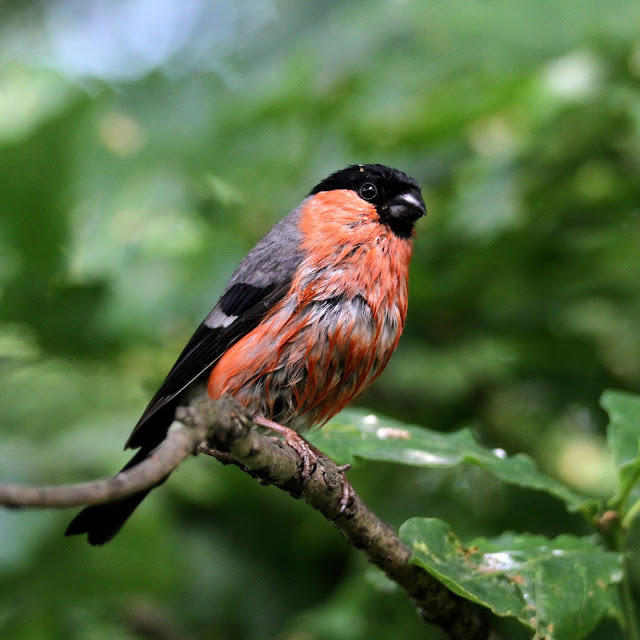My Blog List
Thursday 30 July 2015
Wednesday 29 July 2015
Near miss
It was always going to be a tricky shot. The young fox was on the move on the other side of the hedge. This was the best I could manage. A pity as it was nearly a good photo.
Monday 27 July 2015
Black and white poppy pollen
It has been fascinating to watch the bees collect pollen from the poppies in the garden. Perennial poppies, Papaver orientale, have black pollen while annual poppies, P. commutatum or P. somniferum, produce almost white pollen.
Both bumblebees and honey bees collect pollen from both types of poppy. The only bumblebees I have seen doing this are buff-tails.
The bumblebees climb into the flowers and buzz to dislodge the pollen which collects on the hairs on their bodies. The high-pitched buzz can be heard right across the garden. Here you can see the pollen from a perennial poppy on the buff-tailed worker's back, in her pollen baskets and staining the inside of the petals.
Here a bee is working inside the flower.
Here you can hear the bumblebee at work.
Honey bees also climb through the anthers to collect pollen but I haven't heard them buzzing in the same way. This one is in an annual poppy.
This honey bee is collecting black pollen in a perennial poppy.
Both bumblebees and honey bees collect pollen from both types of poppy. The only bumblebees I have seen doing this are buff-tails.
The bumblebees climb into the flowers and buzz to dislodge the pollen which collects on the hairs on their bodies. The high-pitched buzz can be heard right across the garden. Here you can see the pollen from a perennial poppy on the buff-tailed worker's back, in her pollen baskets and staining the inside of the petals.
Here a bee is working inside the flower.
This one is in an annual poppy with white pollen.
This bee has a heavy load of orange pollen and has obviously come from working a different type of flower. They are also doing this in partly opened Japanese anemones which have yellow-orange pollen so maybe this one came from there.
They also forage on the more ornamental double-flowered poppies.
The flower benefits from the bee's activities as pollen from other flowers is carried to the stigma.
Here you can hear the bumblebee at work.
Honey bees also climb through the anthers to collect pollen but I haven't heard them buzzing in the same way. This one is in an annual poppy.
This honey bee is collecting black pollen in a perennial poppy.
Saturday 25 July 2015
Summer bullfinches
Bullfinches have been visiting the feeders in the garden many times every day this summer.
This chap has just come out of the bath.
Two of the visiting males are ringed but neither of them is the ringed bird I saw last year. This is ****11*, probably L99611*.
This chap has just come out of the bath.
Two of the visiting males are ringed but neither of them is the ringed bird I saw last year. This is ****11*, probably L99611*.
I have worked out the complete number on this bird - L996074 - and have reported it to Euring.
Strangely I hadn't seen any youngsters until yesterday, despite there being plenty of juvenile goldfinches, greenfinches and chaffinches about. The second one here has also been in the bath.
Bullfinches seem to like sunflower hearts best and prefer to feed from the tray rather than the ports on the feeder. They are often there three or four at a time.
Friday 24 July 2015
Ants in his pants
Something I have never seen before - a great tit aggravating the ants on the terrace this afternoon and letting them run onto its wings and tail. Known as "anting", this is more common behaviour in blackbirds and thrushes - it is thought that the bird provokes the ants to squirt formic acid in order to kill off feather lice and mites. This bird was there for at least five minutes.
Then another bird stopped by to watch what was going on. It looks as though it could do with a bit of treatment itself.
Then another bird stopped by to watch what was going on. It looks as though it could do with a bit of treatment itself.
Thursday 23 July 2015
Azure damselfly
The azure damselfly (Coenagrion puella) is perhaps less common than the common blue but there are still a lot of them around. The male has a narrower shoulder stripe than the common blue and an extra short black line on the thorax - the coenagrion spur.
These I think are immature males.
Females are mostly green and are harder to find.
And this is an immature female, I think.
Here are mating pairs.
Here they are ovipositing en masse.
Here is an ovipositing pair of azure damselflies on the left and a pair of common blues on the right.
These I think are immature males.
Females are mostly green and are harder to find.
And this is an immature female, I think.
Here are mating pairs.
Here they are ovipositing en masse.
Here is an ovipositing pair of azure damselflies on the left and a pair of common blues on the right.
Subscribe to:
Posts (Atom)



















































